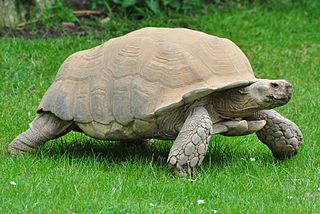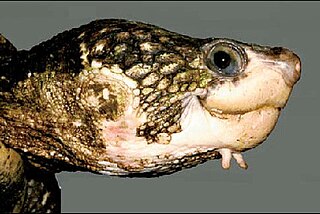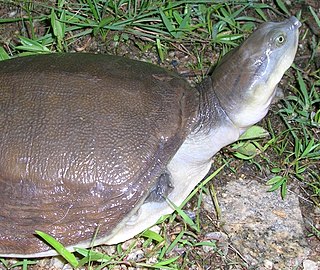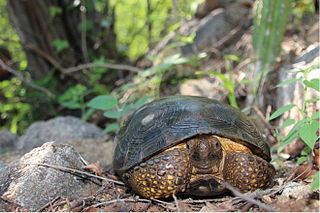
Trachemys is a genus of turtles belonging to the family Emydidae. Members of this genus are native to the Americas, ranging from the Midwestern United States south to northern Argentina, but one subspecies, the red-eared slider, has been introduced worldwide. Species under this genus are commonly referred to as sliders.

The Bolson tortoise, also called the Mexican giant tortoise or yellow-margined tortoise, is a species of tortoise from North America. Of the six North American tortoise species, it is the largest, having a carapace length of about 46 cm (18 in). It lives in a region of the Chihuahuan Desert known as the Bolsón de Mapimí, which is located in north-central Mexico.

The Texas tortoise is a species of tortoise in the family Testudinidae. The species G. berlandieri is one of six species of tortoises that are native to North America.

The African spurred tortoise, also called the sulcata tortoise, is an endangered species of tortoise inhabiting the southern edge of the Sahara Desert, the Sahel, in Africa. It is the largest mainland species of tortoise in Africa, and the third-largest in the world, after the Galapagos tortoise and Aldabra giant tortoise. It is the only living species in its genus, Centrochelys, with the five other species in the family already extinct.

The Asian giant softshell turtle, also known commonly as Cantor's giant softshell turtle and the frog-faced softshell turtle, is a species of freshwater turtle in the family Trionychidae. The species is native to Southeast Asia. The species is critically endangered and in the 20th century has disappeared from much of its former range.

Irwin's turtle is a rare species of freshwater turtle in the family Chelidae. The species is endemic to Australia, originating from the lower region of the Burdekin River area in northern Queensland, and was named after conservationist and television personality Steve Irwin.

The Burmese flapshell turtle, is a species in the family Trionychidae. The species is endemic to Asia.

Cyclanorbis is a genus of softshell turtles in the family Trionychidae. The genus is endemic to Africa.

The Senegal flapshell turtle is a species of turtle in the subfamily Cyclanorbinae of the family Trionychidae. The species, which is one of two species of softshell turtles in the genus Cyclanorbis, is endemic to Africa.
The variable mud turtle, also known as Rhodesian mud turtle, Mashona hinged terrapin or variable hinged terrapin, is a species of turtle in the family Pelomedusidae. It is widely distributed in Central, East, and Southern Africa. The species was officially described by John Hewitt in 1927 and had to be broken into subspecies due to color variations on the heads of the turtles acrost the regions.

Elseya albagula, commonly known as the white-throated snapping turtle, is one of the largest species of chelid turtles in the world, growing to about 45 cm (18 in) carapace length.

Aubry's flapshell turtle is a species of softshell turtle in the family Trionychidae. The species is endemic to Central Africa.

Cyclanorbinae, also known commonly as the flapshell turtles, is a subfamily of softshell turtles in the family Trionychidae. The subfamily is native to Africa and Asia.

The African softshell turtle, or Nile softshell turtle, is a large species of softshell turtle from freshwater and brackish-water habitats in Africa and the Near East. It is the only extant species in the genus Trionyx; historically, despite other species having been formerly placed in this genus as well, they have all been reclassified to other genera. Despite the common name of "African softshell turtle", Trionyx triunguis is not the sole species of softshell turtle found in Africa—the generas Cyclanorbis and Cycloderma are African—nor is it solely found on that continent, alone. T. triunguis is a very large species of softshell turtle, with sizes ranging from 85 to 94 cm, with a weight of 40 kg, and an unconfirmed max size of 120 cm. They are omnivorous in their diet, consuming not only small fish, frogs, tadpoles and crustaceans, but also floating palm seeds and fallen leaves, and some aquatic vegetation.

The Mexican mud turtle, is a species of mud turtle in the family Kinosternidae. Endemic to Mexico, it is found in Aguascalientes, Colima, Durango, Guanajuato, Guerrero, Hidalgo, Jalisco, Michoacán, México, Morelos, Nayarit, Oaxaca, Puebla, Queretaro, San Luis Potosí, Sinaloa, Sonora, Tamaulipas and Zacatecas, where they inhabit moist environments, such as shallow ponds, lakes, rivers or intermediate temp. tropical forest areas.
The Ivory Coast mud turtle is a species of turtle in the family Pelomedusidae. It is one of the most recently described turtle species.
The Pelusios cupulatta is typically found in riverine and wetland habitats mainly located in the southern Ivory Coast of West Africa. Endemic to the Upper Guinean forest region such as wetlands/rivers they are usually found primarily in forested banks as well as aquatic vegetation. Compared to other counterparts within its family, P. Cupulatta prefers an abundance of aquatic vegetation as its primary habitat. Despite this, Pelusios castaneus is a potential competitor due to similar habitats albeit different preferences regarding specific locations. Interspecific competition is able to regulate the coexistence of potential competitors but also niche expansion is available within the family when alone.
Comparative to other species at a local spatial level, Pelusios niger and Pelusios cupulatta both belong to larger size categories compared to others within the Pelusios records with the maximum male SCL being 31.3 and the maximum female SCL being 27.1. The two different turtle species are also allopatric, meaning that they are related but occur in separate non-overlapping geographical areas compared to the sympatric of P. castaneus. White P. castaneus intensely uses forested banks, P, and cupulatta aren't typically found in such areas as they aim for places with large amounts of aquatic vegetation. In presence of P. niger, P. cupulatta are usually found less than 10 km away showing how closely these two groups typically reside at roughly close locations.
The African dwarf mud turtle is a species of turtle in the family Pelomedusidae. It is endemic to Africa : in Angola, the Democratic Republic of the Congo, Malawi, and Zambia. These mud turtles are the smallest of all African turtle species, “Nanus” which they are referred to are one of the 3 smallest turtle species in the world. The other two are Stink Pot Musk and Muhlenberg's Bog Turtles. All 3 species barely reach 4 inches as full grown adults. Like many of the world's chelonians, Pelusios castaneus has the potential to live a long life. Reports typically suggest more than 50 years in captivity for this species.

Centrochelys is a genus of tortoise. It contains one extant species and several extinct species:

The Khorat snail-eating turtle is a species of turtle in the family Geoemydidae. They are freshwater turtles from Khorat Plateau in Thailand but were found for the first time in Udon Thani, Thailand.

The Goode's thornscrub tortoise, also known as the Sinaloan thornscrub tortoise, Sinaloan desert tortoise or Goode's desert tortoise, is a species of tortoise that is native to the Sinaloan desert region. First described in 2016, G. evgoodei inhabits Tropical Deciduous Forest and Sinaloan Desertscrub biomes in Mexico. Its range may overlap in the north with G. morafkai, the Morafka's or Sonoran desert tortoise.


















